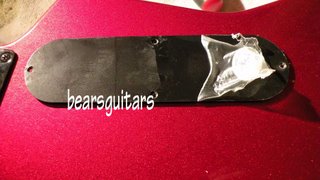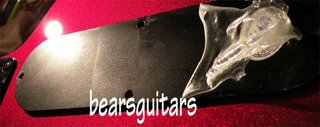Plastic film on Guitar and Bass parts: Leave it on?

I've seen this entry's question hundreds of times, and have been asked about it many times: "Should I leave the protective plastic on my guitar/bass pickguard, back plates, and covers?"
Let's look at both sides of the answer, then I'll share my own answers...
On the "yes" side
• It looks nice when the protective film is on the pickguard/part. Especially if someone has been shredding heavily on the guitar... that way I know that when I take the film off, the plastic will look nice and new...
• If the pickguard really is new (not "It's new, I swear on my old dog Yeller's grave!" new..) I want to sell it as new and give the customer the fun and joy of "that new pickguard look" when they pull the film
• It's there for a reason: to protect the pickguard/part while it is in shipment, and possibly while it is in the guitar/bass store - folks kind of expect not to have a scratched pickguard when they buy a new instrument.
• I like the information stickers, like "Made in the USA!" and "Pull the tone knob for more sounds!" or "Inspected by Fred!".

On the "no" side
• If you leave the film on long-term, it leaves a hard-to-remove residue on the part.
• In some instances, the cheaper PVC-based films will actually eat into the plastic and leave etching in the part... not pretty, and very hard to remove...
• Some folks think that if they play a guitar for a year with the film covers on, they can sell it as "new."
• Enjoy your guitar/bass! Just enjoy it and don't worry about pickguard scratches. That's why the old-timers call them "scratch plates."
My Opinion
I have spent hours trying to remove the residue and etching from three-year-old plastic sticky film. There have been instances where the part/pickguard can't have the film removed at all - it is fused to the part...
If I have a brand new pickguard or part in a factory-closed bag, or if I have a pickguard or part that has just recently been pulled from a new instrument, I will leave the plastic/pvc protective cover on before I sell an item.
If the part is not new, or is not in its original packaging, I remove the plastic film. If the item is from an inexpensive guitar, I definitely take off the film. I don't want to leave someone else with the task of scrubbing the part or potentially having permanent etching in the part.
Labels: back plate, bass, control cavity cover, guitar, guitar stickers, pickguard, plastic, plastic film, pvc, scratchplate, trem cover, tremolo cover






